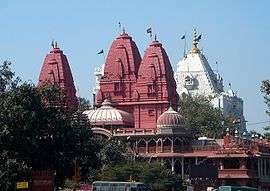Agrawal Jain
| Agrawal Jain | |
|---|---|
 | |
| Religions | Jainism |
| Languages | Haryanvi, Hindi, Rajasthani |
| Populated states | Haryana, Uttar Pradesh, Rajasthan |
| Part of a series on |
| Jainism |
|---|
 |
|
Jain prayers |
|
Ethics |
|
Major sects |
|
Festivals |
|
|
Agrawal Jains are an Indian Jain community who originated from Hisar, Haryana. They are among the most prominent Jain communities.
Legends
According to texts from the Mughal period preserved in Delhi temple libraries, the emergence of the Agrawals is associated with Lohacharya and the Kashtha Sangh. Lohacharya arrived at Agroha in Vikram Samvat 760. He was given food by the local people and he founded the Kashtha Sangh order by installing a wooden idol. The Kashtha Sangh religious order has thus been closely associated with the Agrawal community.
According to some legends, Agrawals were once ruled by a Raja Divakar who was a devout Jain.
History
Agrawal Jains in Delhi
The Agrawal merchant Nattal Sahu and the Agrawal poet Vibudh Shridhar lived during the rule of Tomara Anangapal of Yoginipur (now Mehrauli, near Delhi).[1] Vibudh Shridhar wrote Pasanahacariu in 1132, which includes a historical account of Yoginipur (early Delhi near Mehrauli) then.
In 1354, Firuz Shah Tughluq started the construction of a new city near Agroha called Hisar-e Feroza "Firuz's Fort". Most of the raw material for building the town was brought from Agroha.[2] Hisar was a major center of the Agrawal community.
Some Agrawals rose to good positions in Mughal period, specially during Akbar. Sahu Todar was a supervisor of the royal mint at Agra, who had rebuilt the 514 Jain stupas at Mathura in 1573, during the rule of Akbar.[3]
Sah Ranveer Singh was a royal treasurer during the rule of Akbar. He established the town Saharanpur. His father as well as son and grandson had built several Jain temples,[3] including the one at Kucha Sukhanand in Delhi.
Agrawal Jains in Rajput Kingdoms
Many Agrawals migrated to Rajasthan. They form a large fraction of the merchant population of Shekhawati region. Along with Maheshwari, Khandelwal and Oswals, they form the Marwari bania community.
In the early 15th century, Agrawals flourished as a trader community under the Tomaras of Gwalior.[4]
Historian K.C. Jain comments:
| “ | Golden Age of the Jain Digambar Church in Gwalior under the Tomara rulers inspired by the Kashtha Bhattarakas and their Jain Agrawal disciples who dominated the Court of father and son viz. Dungar Singh (1425-59)and Kirti Singh (1459-80) with the Poet-Laureate Raighu as their mouthpiece and spokesman, a centenarian author of as many as thirty books, big and small of which two dozen are reported to be extant today. Verify the advent of the Hisar-Firuza-based Jain Agrawals who functioned as the ministers and treasurers of the ruling family had turned the Rajput State of Gwalior into a Digambara Jain Centre par excellence representing the culture of the Agrawal multi-millionner shravakas as sponsored by them.[4] | ” |
In the 15th century, many Agrawals migrated to Amer kingdom (now Jaipur). In VS 1535, Agrawal Nenasi conducted a Panch-kalyanak Pratishtha ceremony at Sanganer.[5] A copy of Amarsen Chariu copied in VS 1577 at Sonipat was found at Amer, suggesting that Agrawals took sacred texts with them during this migration.[6]
Prachin Shri Agarwal Digambar Jain Panchayat
Seth Girdhari Lal, the son of Raja Shugan Chand, founded the organization Hissar Panipat Agarwal Jain Panchayat. It is now known as Prachin (i.e. old) Shri Agarwal Digambar Jain Panchayat.[7] It is the oldest Agrawal Jain organization. It has been led by descendants of same family.[8] The organization manages the historical Naya Mandir as well as the Lal Mandir.
The Panchayat has been active in promoting unity among Jains of different sectarian backgrounds.[9]
Notable people
- Jinendra Varni compiler of the five volume "Jainendra Siddhanta Kosha" and Saman Suttam compilation.[10]
See also
References
- ↑ An Early Attestation of the Toponym Ḍhillī, by Richard J. Cohen, Journal of the American Oriental Society, 1989, p. 513-519
- ↑ "The story of Hisar". Tribuneindia.com. 2001-08-18. Retrieved 2011-11-12.
- 1 2 Jyotiprasad Jain, Pramukh Jain Etihasik Purush aur mahilayen, Bharatiya Jnanapitha, 1975
- 1 2 Kashtha Sangha Bhattarakas of Gwalior and Agrawal Shravakas, Dr. K. C. Jain
- ↑ Jain Inscriptions of Rajasthan, R.V. Somani, 1982
- ↑ Amarasena Chariu, Dr. Kasturchand Jain Suman, 1990
- ↑ Court calls for Lal Mandir antique idol, Dec 31, 2011, http://articles.timesofindia.indiatimes.com/2011-12-31/delhi/30576182_1_antique-idol-summons-international-market
- ↑ Progressive Jains Of India Satish Kumar Jain, Shraman Sahitya Sansthan, 1975
- ↑ Ahimsa Times, February, 2005, DIGAMBAR JAIN ORGANISATION IN DELHI BECOMES A PIONEER PATH BREAKER FOR UNITY IN JAIN SOCIETY, http://jainsamaj.org/magazines/ahimsatimesshow.php?id=85
- ↑ Progressive Jains of India By Satish Kumar Jain, 1975, Shraman Sahitya Sansthan